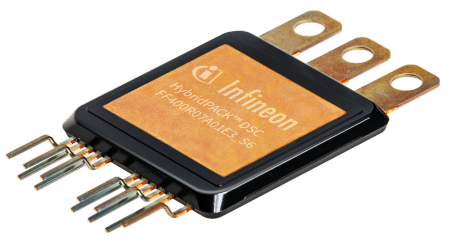In order to meet CO 2 regulations worldwide by 2020, a larger number of electric or hybrid vehicles (HEV) is essential. The targets amount to only 95 gram CO 2 per kilometer in Europe, 121 g/km in the US, 117 g/km in China and 105 g/km in Japan. When electrifying existing car platforms, space constraints are a significant challenge. As the inverter has to be placed in the typically cramped engine department, it has to be as small as possible. Inverter size is mainly defined by the power modules employed. Consequently, these have to become smaller while at the same time providing sufficient power to actuate the electric drivetrain. The size of a power module, on the other hand, is defined by the power consumption of the power chips used inside, and the ability to cool these chips to stay below a maximum junction temperature.
Helping to overcome these challenges, Infineon Technologies AG (FSE: IFX / OTCQX: IFNNY) presents its latest power module family HybridPACK™ Double Sided Cooling (DSC) for hybrid and electric vehicles at the PCIM 2016 tradeshow. The new power modules have extremely small dimensions of only 42 mm x 42.4 mm x 4.77 mm. They target HEV applications such as main inverters and generators with a typical power range of 40 to 50 kW. In order to support higher power, they can be used in parallel configurations.
With only 15 nH, the stray inductance is very low while blocking voltage was increased to 700 V. Both factors support the development of inverter systems with reduced switching losses of about 25 percent and very high efficiency. Thanks to the integrated isolation, the module can be directly attached to a cooler without external isolation thus simplifying system integration. Each integrated IGBT chip is equipped with an on-chip current sensor for overcurrent protection. In addition, an on-chip temperature sensor provides derating and fast shut-off in case of over-temperature. The direct and precise sensing improves system monitoring. It also helps to simplify the functional safety architecture of automotive system suppliers and car manufacturers.
By combining double sided chip cooling with electrical isolation of the heat sinks, the thermal resistance R thJC of the HybridPACK DSC is significantly reduced to 0.1 Kelvin/Watt (K/W). In comparison, today’s power module HybridPACK 1 has a thermal resistance of 0.12 K/W. The HybridPACK DSC module technology also improves the electrical performance. Stray inductance is one major parameter, defined by module size and the careful routing of the current path through the module. The HybridPACK DSC value of only 15 nH is about 40 percent lower compared to reference modules. The result is a reduction of switching losses by 25 percent.
Availability of HybridPACK DSC power modules
The first member of the HybridPACK DSC family is the FF400R07A01E3_S6 implementing I Cnom of 400 A and V CES of 700 V in half-bridge configuration. Engineering samples will be available in September 2016. A further product in the family implementing I Cnom of 200 A and V CES of 700 V in a full-bridge configuration will be offered as engineering samples in October 2016. Further variants featuring different power ranges are under development.



















